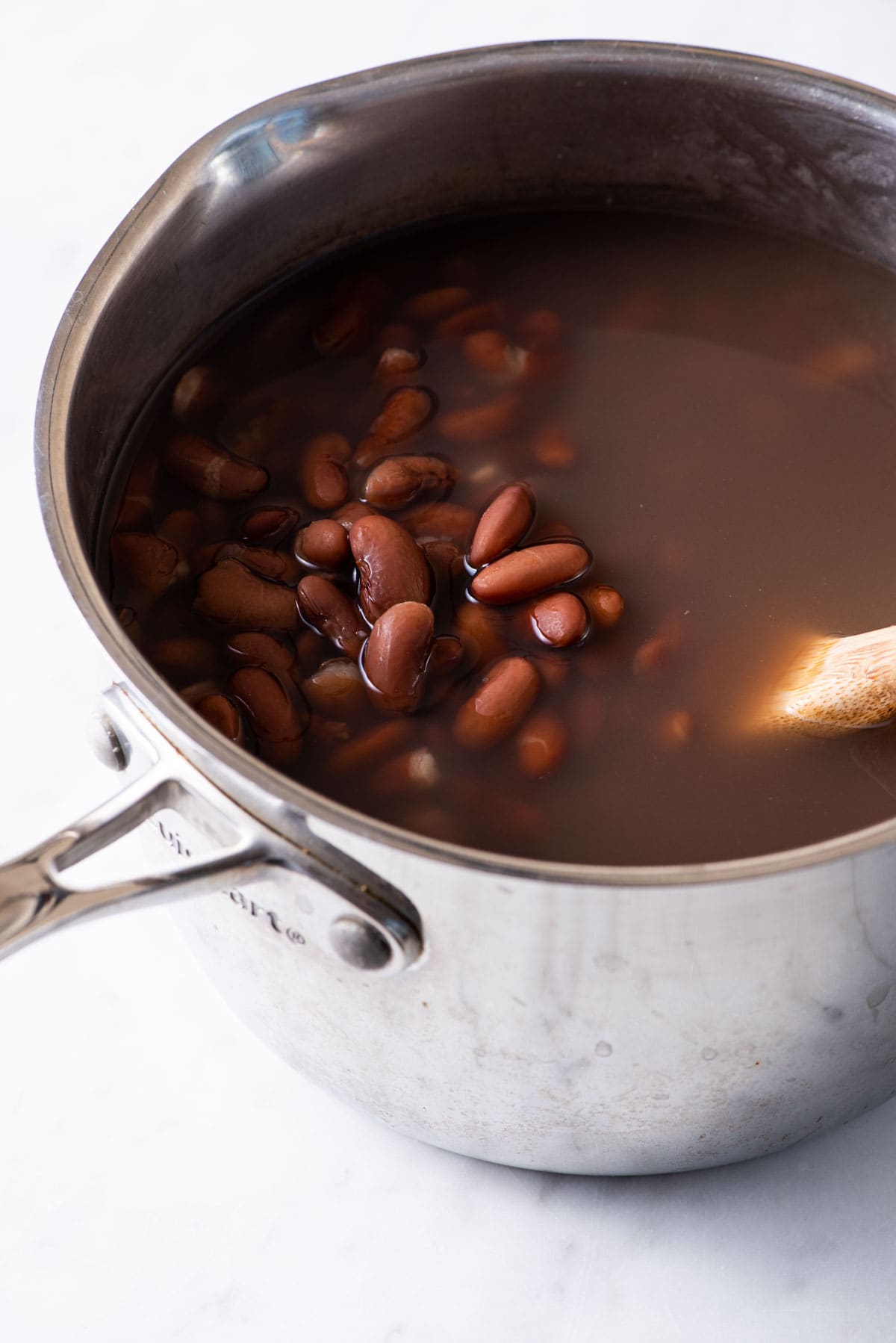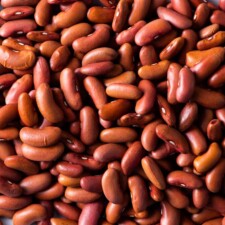Intimidated by cooking dried beans from scratch? Sick of ending up with overcooked or broken beans? Read on for all my cooking tips (plus one major secret) to perfectly creamy beans, every time.

In my last five years as a pro recipe developer, one thing has become abundantly clear: most people – even avid cooks – shy away from cooking dried beans from scratch. They wanna do it, but after one too many failed attempts, they’ve given up and resigned to the canned variety.
The first thing that trips people up is not knowing whether to soak the beans, and if they do choose to, there’s the issue of planning ahead – and who has time for that? (I have a solution – see below!) The most common complaint, though: beans with burst skins.
Since I don’t cook with meat or dairy, beans are a huge part of my diet and the focal point of many of my meals. I’ve cooked countless pots of beans over the years and have picked up a handful of tricks for fool-proof, perfectly-cooked beans from scratch. Every. single. time.

To Soak or Not to Soak
So yes, you can cook dried beans without soaking them, but you’d be doing yourself a disservice. The number one reason to soak them is to reduce the presence of oligosaccharides, the [often] flatulence-producing compound in beans. Soaking makes beans easier to digest and their nutrients easier to absorb. Another reason to pre-soak is to help the beans cook more evenly.

How to Cook Dried Beans on the Stove
Here’s my guide for how to cook the best dried beans from scratch. This process works for all types of beans: white, black, kidney, pinto, etc. This guide does not pertain to chickpeas or lentils.
Step 1: Soak your beans.
There are two ways to soak beans…
- Cold Soak: The typical way is to cover beans with a generous amount of cold water and let them stand at room temp for at least 8 hours or overnight. (I like to soak beans in the same pot I plan to cook them in.) This technique requires planning ahead. But, if plans change and you can no longer cook the beans the next day, you can keep them in the water in the fridge for up to 2 days.
- Hot Soak: This lesser-known technique works just as well, except you don’t need advance notice. Place beans in a pot and add enough water to cover by about 2 inches. Cover with a lid, bring to a boil, then turn the heat off. Let the beans stand for 1 hour (or up to several hours).

Step 2: Choose the right pot.
Dried beans triple in volume when cooked, so choose a pot that will accommodate them properly in their future state. You want the beans to fit in the pot snuggly, though – they should not be swimming in an obscenely large volume of water. If there’s way more water than beans in the pot, you risk them becoming waterlogged. (I use a 3-quart pot to cook 1 pound of beans.)
Step 3: Start cooking the beans.
Drain and rinse your soaked beans under running water. Then add enough new water to cover the beans by about 2 inches. Add 1/4 teaspoon salt, cover with a lid, and bring to a boil.
Step 4: Simmer very gently.
Once boiling, reduce the heat to a tiny flame – this is one of the most important parts of the process (I usually simmer them on the back burner). You should only be seeing the tiniest bubbles breaking on the surface of the water. If it’s boiling too rapidly, you risk splitting the beans’ skins. Keep the lid on the pot ajar for the entire time. And lastly, there’s no need to stir (this also helps preserve the skins).

Step 5: Undercook the beans.
Yes, you read that correctly. My secret to cooking perfectly creamy beans with intact skins is to undercook them slightly and let them sit in the hot water for a bit to finish cooking heat-free. (I’ve found that if I simmer them til the very end, I risk overcooking them.) How do you know when to turn them off? Taste a few. When they’re almost cooked through but still have a tiny bite on the inside – and the skins still have some resistance – that’s when you take them off the flame.
Step 6: Add salt and set aside.
Add salt (1-2 teaspoons salt per pound of beans) and stir gently to avoid breaking up the beans. Set the pot aside and let the beans sit in the water for an additional 30 to 60 minutes; the residual heat in the water will finish tenderizing the beans without bursting the skins. (I like to add salt at the end to avoid toughening the skins.)

Step 7: Use in a recipe or store for the week.
After the beans have reached that perfect creamy texture, drain them, and either use in a recipe or store in the fridge for up to a week. Feel free to reserve the bean-cooking liquid for other purposes; it has a lot of flavor and a slightly viscous texture perfect for chili (instead of veg broth) and refried beans.
Ways to Use Freshly Cooked Beans
Ready to put those home-cooked beans to good use? Make…
- Pinto Bean Salad
- Mexican Black Bean Dip
- White Bean Puree with Fried Leeks
- Black Bean and Plantain Bowls
- Farro Bowls with Herby Beans
- Vegan Cassoulet
- Lobio (Georgian Bean-Walnut Stew)
- Tuscan Beans on Toast

Frequently Asked Questions
Beans’ cooking time depends on their size and age (older beans take longer), as well as your stove, the pot you’re cooking them in, and whether or not they’ve been soaked. Typically, it’s 45 minutes to 1.5 hours. I start checking my beans after 30 minutes.
Bean skins may be tough if: your beans are too old, you added too much salt in the beginning of cooking, or you used an acidic ingredient (like tomatoes) in the cooking liquid.
Dried beans may fall apart while cooking on the stove if: the water is boiling too rapidly, or you’re using too much water to cook the beans.
Try to seek out the freshest beans possible. Look for them at a farmers market (FYI, these have a premium price tag) or order from cult favorite Rancho Gordo. Basic supermarket beans are totally fine, though. Avoid stores that don’t sell a lot of beans like your corner bodega, which likely keeps the same bag of beans on the shelf for a year.
Depending on how you plan to use the beans, you can flavor the water with various things. My go-to’s: a few halved garlic cloves, cumin seeds, and bay leaves. You can also add a halved onion, carrot, and/or celery (especially good if you wanna turn the beans into soup later), as well as lemon rind, fresh herbs, or other spices.
Let me know if you try this technique! Rate the recipe and leave a comment below, and tag @thenewbaguette on Instagram with your results.
The Full Recipe
Print
How to Cook Dried Beans on the Stove
- Prep Time: 5 mins
- Cook Time: 2 hours
- Total Time: 2 hours 5 minutes
- Yield: About 6 cups cooked beans 1x
- Category: Guide
- Method: Stovetop
- Cuisine: n/a
- Diet: Vegan
Description
Here’s my technique for cooking perfectly creamy beans – every time.
Ingredients
- 1 pound dried beans (white, black, kidney, pinto, etc.)
- Fine sea salt, to taste
- Optional aromatics: fresh garlic, halved onion, carrots, celery, bay leaves, spices, lemon rind, or fresh herbs
Instructions
- Soak the beans. Method 1: If you have 8 or more hours, place the beans in a pot, add enough water to cover by about 2 inches and set aside for at least 8 hours. Method 2: If you only have 1 hour to spare before cooking your beans, place them in a pot and add enough water to cover by about 2 inches. Cover with a lid, bring to a boil, then turn the heat off, and let stand for an hour.
- Start cooking the beans. Drain and rinse the soaked beans, and return to the pot. Add enough new water to cover by about 2 inches, as well as 1/4 teaspoon salt. Cover and bring to a boil. (You can add aromatics at this point if you want.)
- Simmer very gently. Reduce the heat to very low and simmer with the lid ajar until the beans are almost cooked through, but still have a tiny bite and the skins still have some resistance (start checking after 30 minutes). Make sure the beans are simmering very gently the whole time – you should only see a few tiny bubbles breaking on the surface.
- Salt and set aside. At this stage, turn the heat off and gently stir in 1 to 2 teaspoons salt (depending on how you plan to use them). Set aside for 30 to 60 more minutes so the beans finish cooking in the residual heat.
- Drain. When the beans have reached a perfectly creamy texture, drain them and use as desired. You can save the bean cooking liquid, if you want, and use it for soup or refried beans (instead of veg broth). Cooked beans will keep in the fridge for 5-6 days.
Nutrition
- Serving Size: 1 cup cooked beans
- Calories: 215
- Carbohydrates: 39.8 g
- Fiber: 13.8 g
- Protein: 13.5 g


Lorraine porta says
I’ve heard you shouldn’t put tomato sauce or canned tomato’s in the pot until the beans are almost cooked. It’s said the beans will not cook tender if you do is that a true statement?
Alexandra Shytsman says
Hi Lorraine. Yes, this is true. Acid (for example from tomatoes, vinegar, or wine) can leave bean skins tough after boiling. I would recommend adding them toward the end of cooking. A bit of tomato paste at the beginning, though, should be fine.